Investigating Physical Activity and Children's Cognitive Development
VerifiedAdded on 2023/06/09
|15
|3193
|184
Report
AI Summary
This report investigates the influence of physical activity on children's cognitive abilities and academic achievement. It begins with an introduction emphasizing the importance of cognitive development and the role of physical activity in enhancing skills, knowledge, and problem-solving. The literature review explores the relationship between physical activity, fitness, and cognitive function, as well as the impact of exercise on children's cognition. The discussion section synthesizes these findings, highlighting the positive effects of physical activity on mental and physical health. The methodology outlines the research philosophy (positivism), approach (deductive), choice (quantitative), strategy (survey), time horizon (cross-sectional), data collection methods (primary and secondary), and data analysis techniques (frequency distribution). The report concludes by summarizing the key findings and implications of the research, underscoring the benefits of physical activity for children's overall development and academic performance. The report also covers the identification of physical activity, fitness, cognitive function and academic achievements in children that help to determine the productivity of children. The report also will cover the effect of physical activity on the children and their cognition.
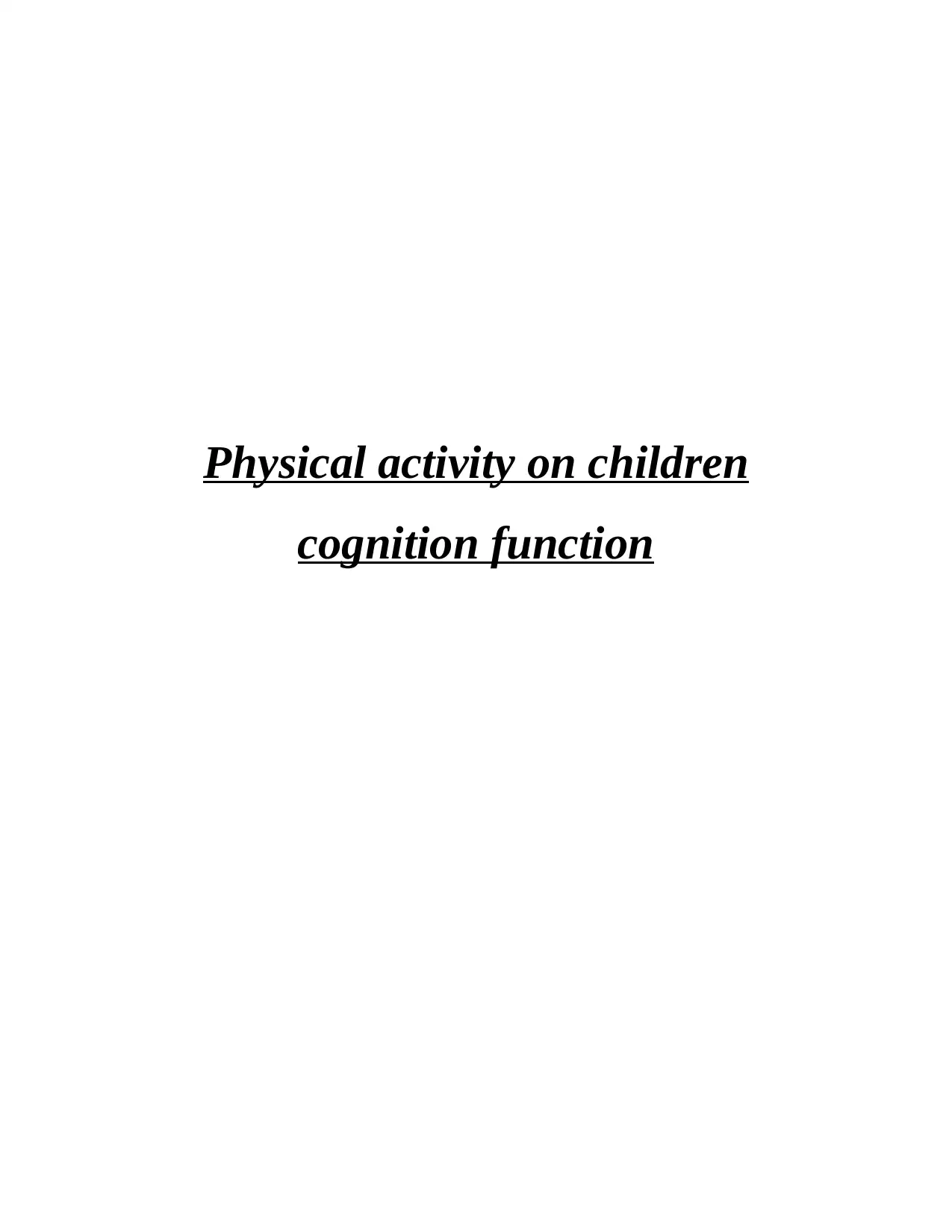
Physical activity on children
cognition function
cognition function
Paraphrase This Document
Need a fresh take? Get an instant paraphrase of this document with our AI Paraphraser
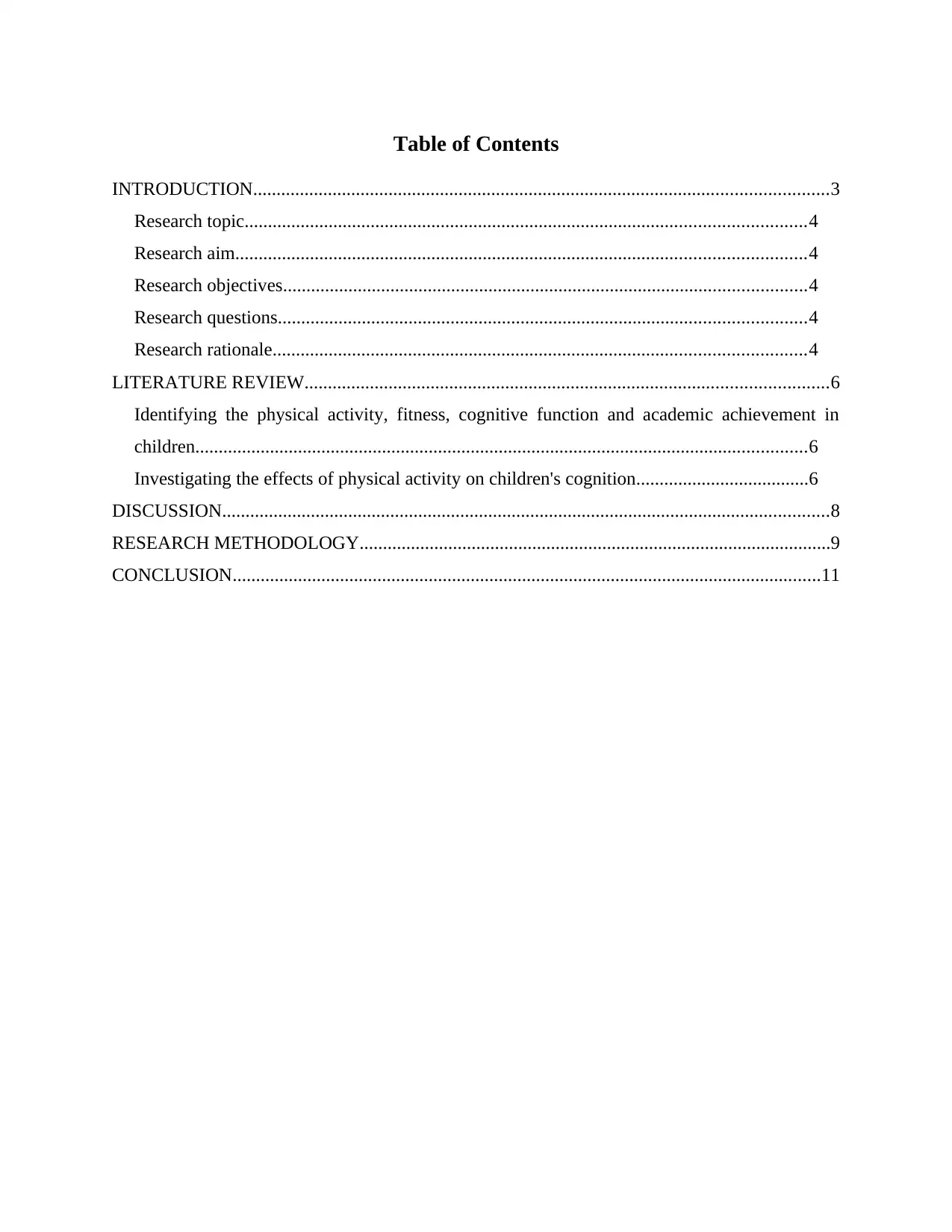
Table of Contents
INTRODUCTION...........................................................................................................................3
Research topic........................................................................................................................4
Research aim..........................................................................................................................4
Research objectives................................................................................................................4
Research questions.................................................................................................................4
Research rationale..................................................................................................................4
LITERATURE REVIEW................................................................................................................6
Identifying the physical activity, fitness, cognitive function and academic achievement in
children...................................................................................................................................6
Investigating the effects of physical activity on children's cognition.....................................6
DISCUSSION..................................................................................................................................8
RESEARCH METHODOLOGY.....................................................................................................9
CONCLUSION..............................................................................................................................11
INTRODUCTION...........................................................................................................................3
Research topic........................................................................................................................4
Research aim..........................................................................................................................4
Research objectives................................................................................................................4
Research questions.................................................................................................................4
Research rationale..................................................................................................................4
LITERATURE REVIEW................................................................................................................6
Identifying the physical activity, fitness, cognitive function and academic achievement in
children...................................................................................................................................6
Investigating the effects of physical activity on children's cognition.....................................6
DISCUSSION..................................................................................................................................8
RESEARCH METHODOLOGY.....................................................................................................9
CONCLUSION..............................................................................................................................11
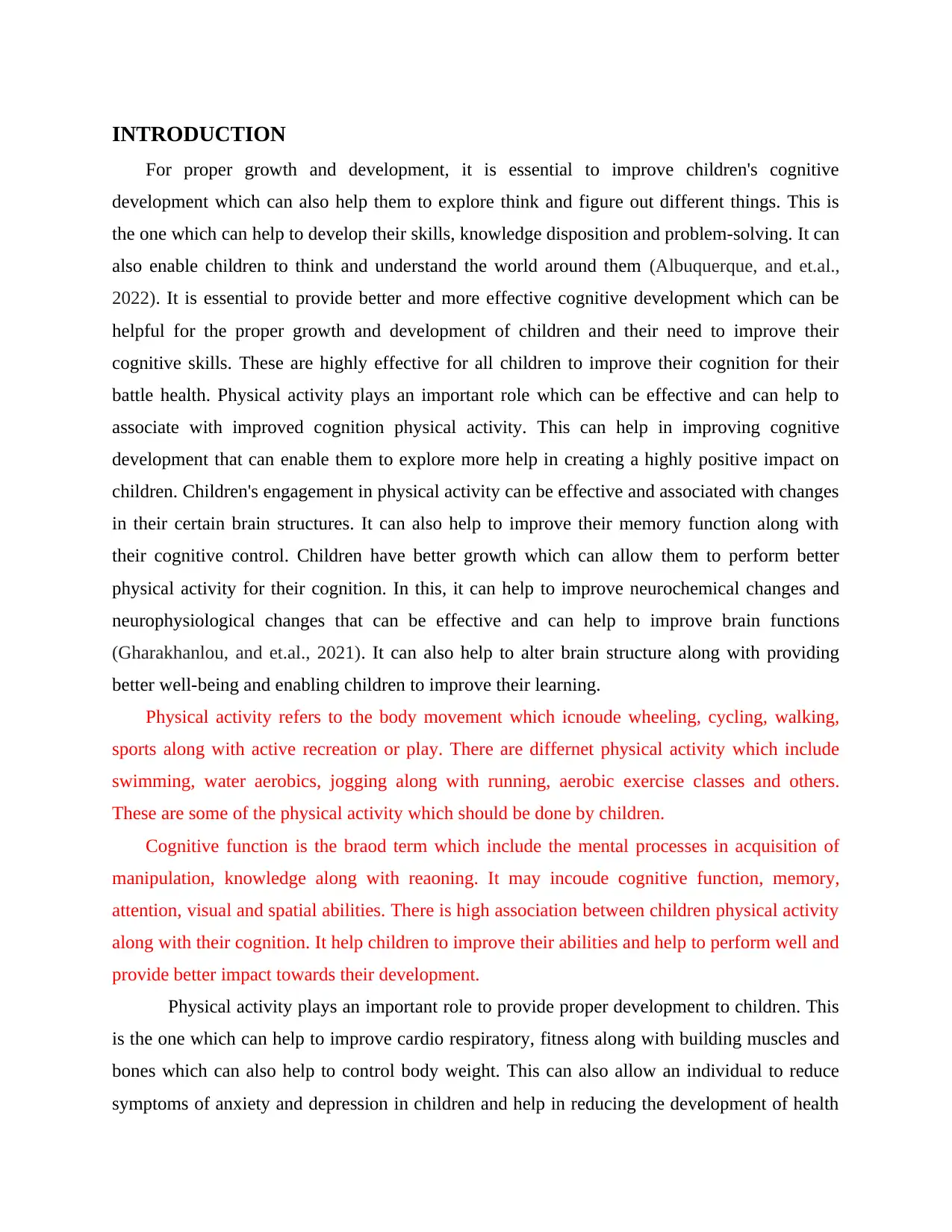
INTRODUCTION
For proper growth and development, it is essential to improve children's cognitive
development which can also help them to explore think and figure out different things. This is
the one which can help to develop their skills, knowledge disposition and problem-solving. It can
also enable children to think and understand the world around them (Albuquerque, and et.al.,
2022). It is essential to provide better and more effective cognitive development which can be
helpful for the proper growth and development of children and their need to improve their
cognitive skills. These are highly effective for all children to improve their cognition for their
battle health. Physical activity plays an important role which can be effective and can help to
associate with improved cognition physical activity. This can help in improving cognitive
development that can enable them to explore more help in creating a highly positive impact on
children. Children's engagement in physical activity can be effective and associated with changes
in their certain brain structures. It can also help to improve their memory function along with
their cognitive control. Children have better growth which can allow them to perform better
physical activity for their cognition. In this, it can help to improve neurochemical changes and
neurophysiological changes that can be effective and can help to improve brain functions
(Gharakhanlou, and et.al., 2021). It can also help to alter brain structure along with providing
better well-being and enabling children to improve their learning.
Physical activity refers to the body movement which icnoude wheeling, cycling, walking,
sports along with active recreation or play. There are differnet physical activity which include
swimming, water aerobics, jogging along with running, aerobic exercise classes and others.
These are some of the physical activity which should be done by children.
Cognitive function is the braod term which include the mental processes in acquisition of
manipulation, knowledge along with reaoning. It may incoude cognitive function, memory,
attention, visual and spatial abilities. There is high association between children physical activity
along with their cognition. It help children to improve their abilities and help to perform well and
provide better impact towards their development.
Physical activity plays an important role to provide proper development to children. This
is the one which can help to improve cardio respiratory, fitness along with building muscles and
bones which can also help to control body weight. This can also allow an individual to reduce
symptoms of anxiety and depression in children and help in reducing the development of health
For proper growth and development, it is essential to improve children's cognitive
development which can also help them to explore think and figure out different things. This is
the one which can help to develop their skills, knowledge disposition and problem-solving. It can
also enable children to think and understand the world around them (Albuquerque, and et.al.,
2022). It is essential to provide better and more effective cognitive development which can be
helpful for the proper growth and development of children and their need to improve their
cognitive skills. These are highly effective for all children to improve their cognition for their
battle health. Physical activity plays an important role which can be effective and can help to
associate with improved cognition physical activity. This can help in improving cognitive
development that can enable them to explore more help in creating a highly positive impact on
children. Children's engagement in physical activity can be effective and associated with changes
in their certain brain structures. It can also help to improve their memory function along with
their cognitive control. Children have better growth which can allow them to perform better
physical activity for their cognition. In this, it can help to improve neurochemical changes and
neurophysiological changes that can be effective and can help to improve brain functions
(Gharakhanlou, and et.al., 2021). It can also help to alter brain structure along with providing
better well-being and enabling children to improve their learning.
Physical activity refers to the body movement which icnoude wheeling, cycling, walking,
sports along with active recreation or play. There are differnet physical activity which include
swimming, water aerobics, jogging along with running, aerobic exercise classes and others.
These are some of the physical activity which should be done by children.
Cognitive function is the braod term which include the mental processes in acquisition of
manipulation, knowledge along with reaoning. It may incoude cognitive function, memory,
attention, visual and spatial abilities. There is high association between children physical activity
along with their cognition. It help children to improve their abilities and help to perform well and
provide better impact towards their development.
Physical activity plays an important role to provide proper development to children. This
is the one which can help to improve cardio respiratory, fitness along with building muscles and
bones which can also help to control body weight. This can also allow an individual to reduce
symptoms of anxiety and depression in children and help in reducing the development of health
⊘ This is a preview!⊘
Do you want full access?
Subscribe today to unlock all pages.

Trusted by 1+ million students worldwide
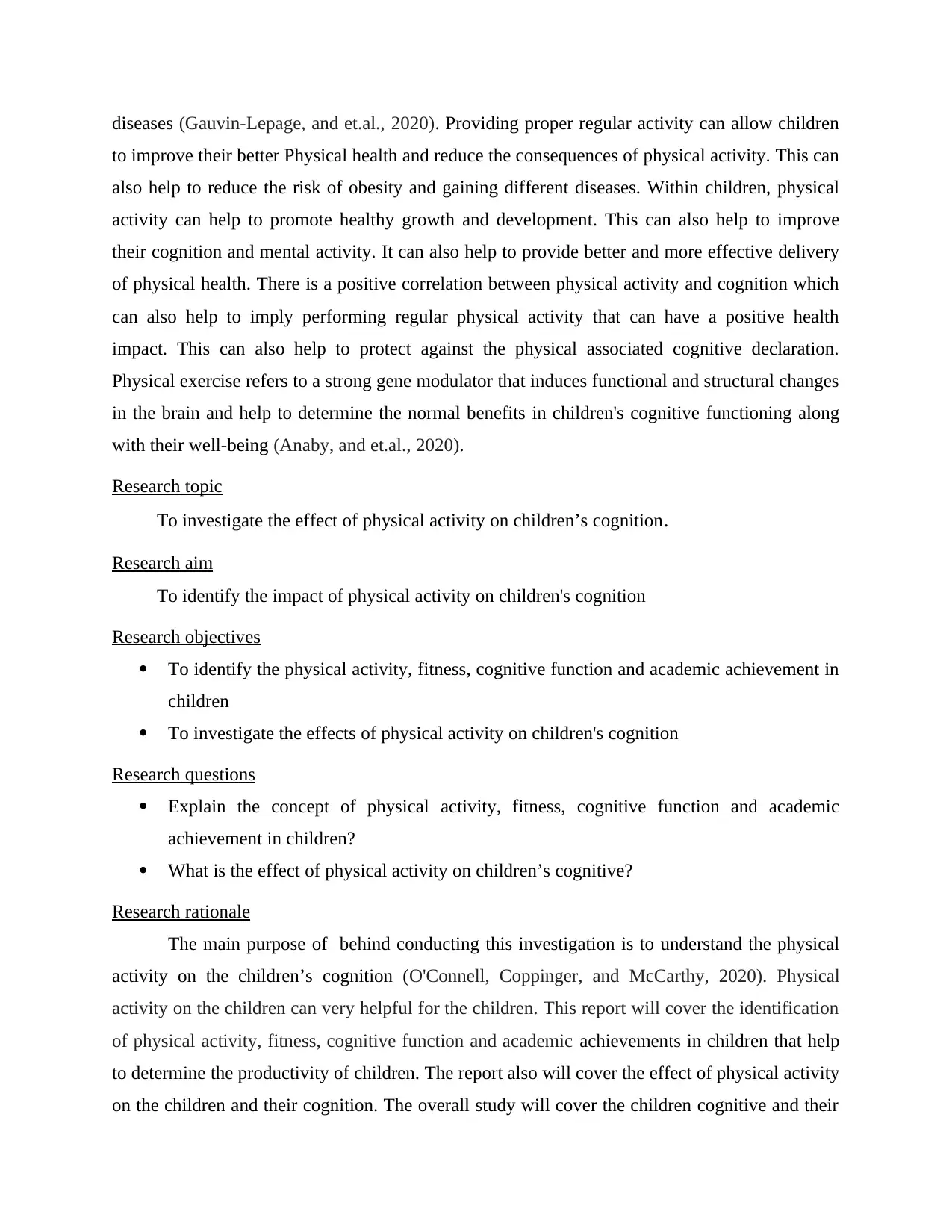
diseases (Gauvin-Lepage, and et.al., 2020). Providing proper regular activity can allow children
to improve their better Physical health and reduce the consequences of physical activity. This can
also help to reduce the risk of obesity and gaining different diseases. Within children, physical
activity can help to promote healthy growth and development. This can also help to improve
their cognition and mental activity. It can also help to provide better and more effective delivery
of physical health. There is a positive correlation between physical activity and cognition which
can also help to imply performing regular physical activity that can have a positive health
impact. This can also help to protect against the physical associated cognitive declaration.
Physical exercise refers to a strong gene modulator that induces functional and structural changes
in the brain and help to determine the normal benefits in children's cognitive functioning along
with their well-being (Anaby, and et.al., 2020).
Research topic
To investigate the effect of physical activity on children’s cognition.
Research aim
To identify the impact of physical activity on children's cognition
Research objectives
To identify the physical activity, fitness, cognitive function and academic achievement in
children
To investigate the effects of physical activity on children's cognition
Research questions
Explain the concept of physical activity, fitness, cognitive function and academic
achievement in children?
What is the effect of physical activity on children’s cognitive?
Research rationale
The main purpose of behind conducting this investigation is to understand the physical
activity on the children’s cognition (O'Connell, Coppinger, and McCarthy, 2020). Physical
activity on the children can very helpful for the children. This report will cover the identification
of physical activity, fitness, cognitive function and academic achievements in children that help
to determine the productivity of children. The report also will cover the effect of physical activity
on the children and their cognition. The overall study will cover the children cognitive and their
to improve their better Physical health and reduce the consequences of physical activity. This can
also help to reduce the risk of obesity and gaining different diseases. Within children, physical
activity can help to promote healthy growth and development. This can also help to improve
their cognition and mental activity. It can also help to provide better and more effective delivery
of physical health. There is a positive correlation between physical activity and cognition which
can also help to imply performing regular physical activity that can have a positive health
impact. This can also help to protect against the physical associated cognitive declaration.
Physical exercise refers to a strong gene modulator that induces functional and structural changes
in the brain and help to determine the normal benefits in children's cognitive functioning along
with their well-being (Anaby, and et.al., 2020).
Research topic
To investigate the effect of physical activity on children’s cognition.
Research aim
To identify the impact of physical activity on children's cognition
Research objectives
To identify the physical activity, fitness, cognitive function and academic achievement in
children
To investigate the effects of physical activity on children's cognition
Research questions
Explain the concept of physical activity, fitness, cognitive function and academic
achievement in children?
What is the effect of physical activity on children’s cognitive?
Research rationale
The main purpose of behind conducting this investigation is to understand the physical
activity on the children’s cognition (O'Connell, Coppinger, and McCarthy, 2020). Physical
activity on the children can very helpful for the children. This report will cover the identification
of physical activity, fitness, cognitive function and academic achievements in children that help
to determine the productivity of children. The report also will cover the effect of physical activity
on the children and their cognition. The overall study will cover the children cognitive and their
Paraphrase This Document
Need a fresh take? Get an instant paraphrase of this document with our AI Paraphraser

achievements for the future goals. It is also provide proper development of children which is the
advantages for the their future success.
advantages for the their future success.
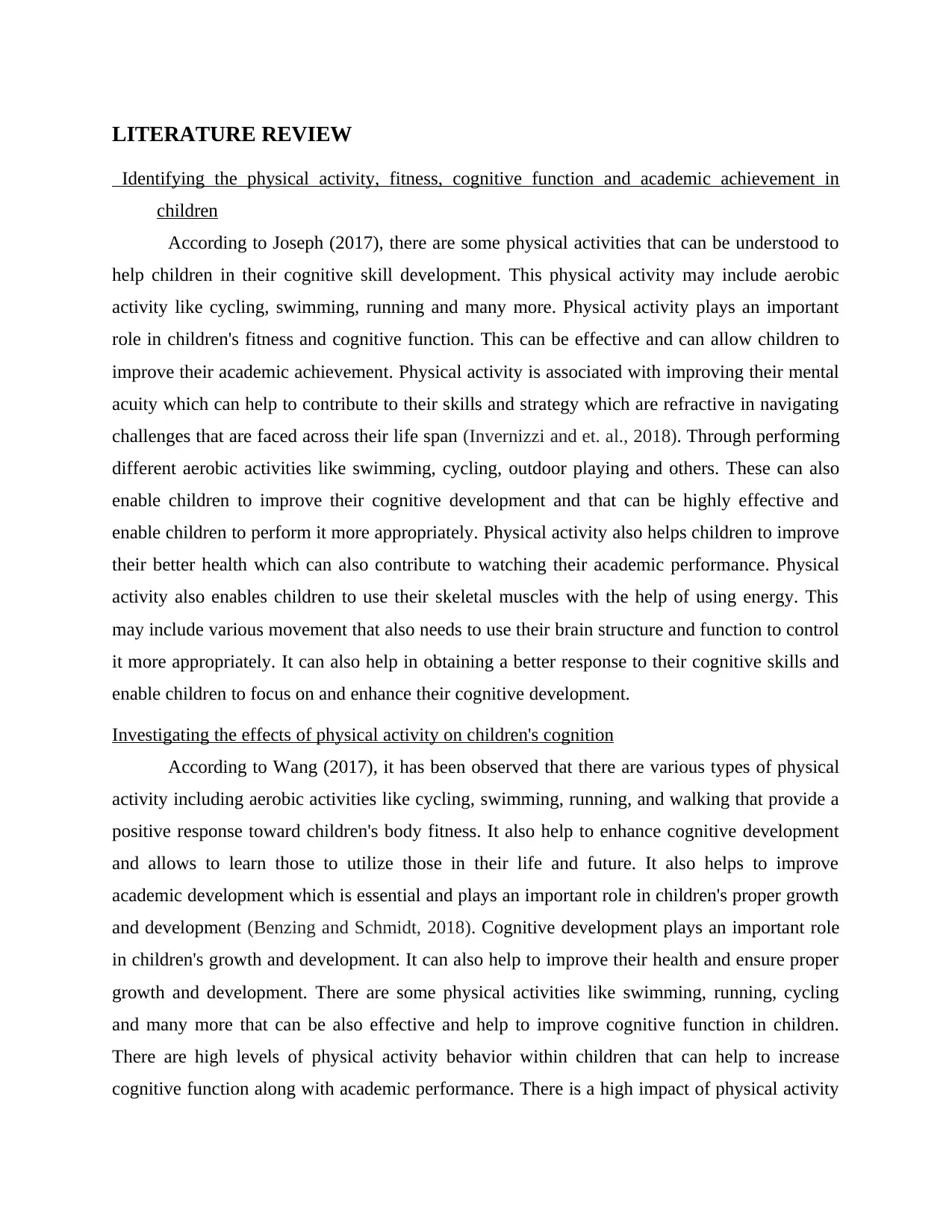
LITERATURE REVIEW
Identifying the physical activity, fitness, cognitive function and academic achievement in
children
According to Joseph (2017), there are some physical activities that can be understood to
help children in their cognitive skill development. This physical activity may include aerobic
activity like cycling, swimming, running and many more. Physical activity plays an important
role in children's fitness and cognitive function. This can be effective and can allow children to
improve their academic achievement. Physical activity is associated with improving their mental
acuity which can help to contribute to their skills and strategy which are refractive in navigating
challenges that are faced across their life span (Invernizzi and et. al., 2018). Through performing
different aerobic activities like swimming, cycling, outdoor playing and others. These can also
enable children to improve their cognitive development and that can be highly effective and
enable children to perform it more appropriately. Physical activity also helps children to improve
their better health which can also contribute to watching their academic performance. Physical
activity also enables children to use their skeletal muscles with the help of using energy. This
may include various movement that also needs to use their brain structure and function to control
it more appropriately. It can also help in obtaining a better response to their cognitive skills and
enable children to focus on and enhance their cognitive development.
Investigating the effects of physical activity on children's cognition
According to Wang (2017), it has been observed that there are various types of physical
activity including aerobic activities like cycling, swimming, running, and walking that provide a
positive response toward children's body fitness. It also help to enhance cognitive development
and allows to learn those to utilize those in their life and future. It also helps to improve
academic development which is essential and plays an important role in children's proper growth
and development (Benzing and Schmidt, 2018). Cognitive development plays an important role
in children's growth and development. It can also help to improve their health and ensure proper
growth and development. There are some physical activities like swimming, running, cycling
and many more that can be also effective and help to improve cognitive function in children.
There are high levels of physical activity behavior within children that can help to increase
cognitive function along with academic performance. There is a high impact of physical activity
Identifying the physical activity, fitness, cognitive function and academic achievement in
children
According to Joseph (2017), there are some physical activities that can be understood to
help children in their cognitive skill development. This physical activity may include aerobic
activity like cycling, swimming, running and many more. Physical activity plays an important
role in children's fitness and cognitive function. This can be effective and can allow children to
improve their academic achievement. Physical activity is associated with improving their mental
acuity which can help to contribute to their skills and strategy which are refractive in navigating
challenges that are faced across their life span (Invernizzi and et. al., 2018). Through performing
different aerobic activities like swimming, cycling, outdoor playing and others. These can also
enable children to improve their cognitive development and that can be highly effective and
enable children to perform it more appropriately. Physical activity also helps children to improve
their better health which can also contribute to watching their academic performance. Physical
activity also enables children to use their skeletal muscles with the help of using energy. This
may include various movement that also needs to use their brain structure and function to control
it more appropriately. It can also help in obtaining a better response to their cognitive skills and
enable children to focus on and enhance their cognitive development.
Investigating the effects of physical activity on children's cognition
According to Wang (2017), it has been observed that there are various types of physical
activity including aerobic activities like cycling, swimming, running, and walking that provide a
positive response toward children's body fitness. It also help to enhance cognitive development
and allows to learn those to utilize those in their life and future. It also helps to improve
academic development which is essential and plays an important role in children's proper growth
and development (Benzing and Schmidt, 2018). Cognitive development plays an important role
in children's growth and development. It can also help to improve their health and ensure proper
growth and development. There are some physical activities like swimming, running, cycling
and many more that can be also effective and help to improve cognitive function in children.
There are high levels of physical activity behavior within children that can help to increase
cognitive function along with academic performance. There is a high impact of physical activity
⊘ This is a preview!⊘
Do you want full access?
Subscribe today to unlock all pages.

Trusted by 1+ million students worldwide

on children's cognitive development through performing various activities, especially like
aerobics activities of the brain in a more effective way. This can also help to use the brain and
improve cognitive function. It can also enable children to get improvement in their academic
performance due to improvement in their cognitive functions.
aerobics activities of the brain in a more effective way. This can also help to use the brain and
improve cognitive function. It can also enable children to get improvement in their academic
performance due to improvement in their cognitive functions.
Paraphrase This Document
Need a fresh take? Get an instant paraphrase of this document with our AI Paraphraser
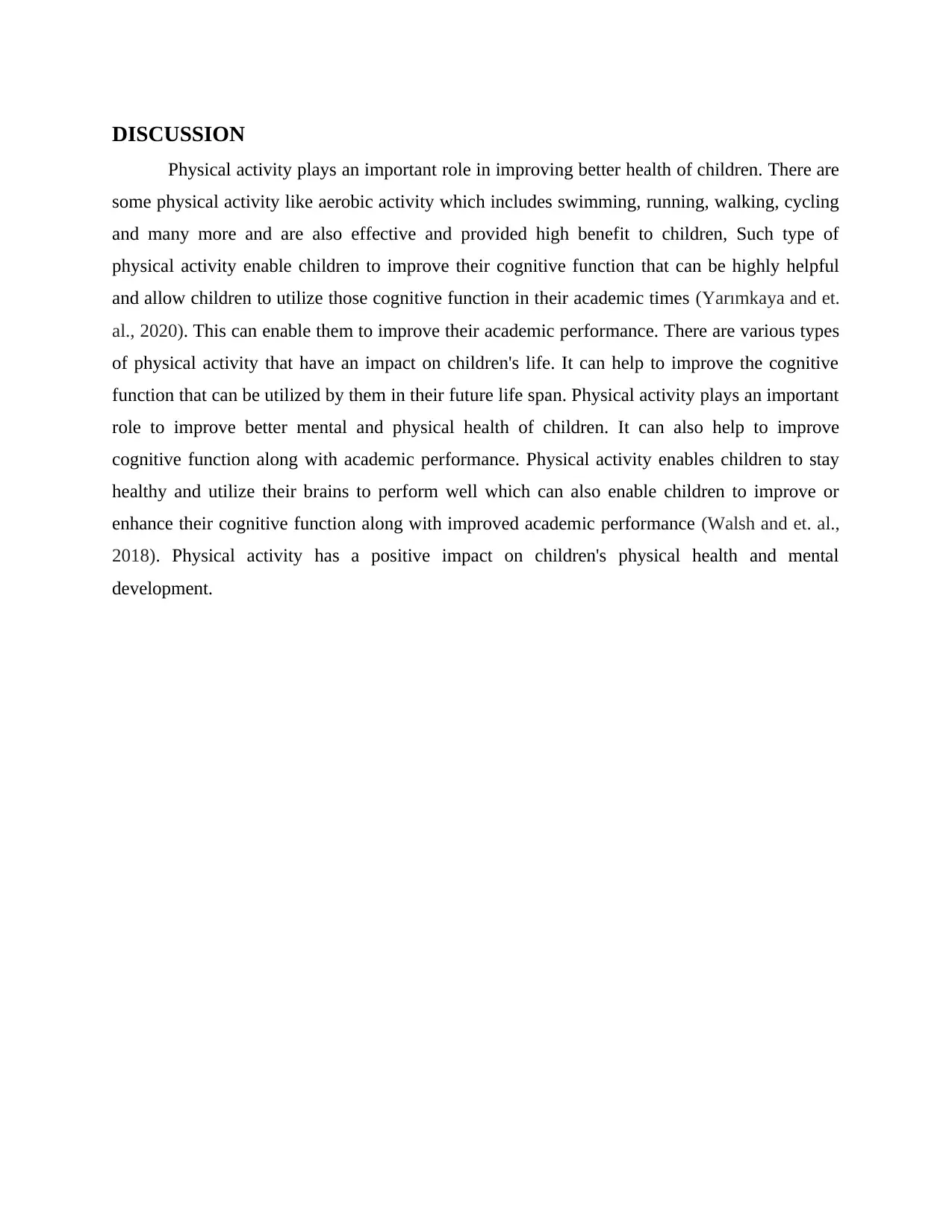
DISCUSSION
Physical activity plays an important role in improving better health of children. There are
some physical activity like aerobic activity which includes swimming, running, walking, cycling
and many more and are also effective and provided high benefit to children, Such type of
physical activity enable children to improve their cognitive function that can be highly helpful
and allow children to utilize those cognitive function in their academic times (Yarımkaya and et.
al., 2020). This can enable them to improve their academic performance. There are various types
of physical activity that have an impact on children's life. It can help to improve the cognitive
function that can be utilized by them in their future life span. Physical activity plays an important
role to improve better mental and physical health of children. It can also help to improve
cognitive function along with academic performance. Physical activity enables children to stay
healthy and utilize their brains to perform well which can also enable children to improve or
enhance their cognitive function along with improved academic performance (Walsh and et. al.,
2018). Physical activity has a positive impact on children's physical health and mental
development.
Physical activity plays an important role in improving better health of children. There are
some physical activity like aerobic activity which includes swimming, running, walking, cycling
and many more and are also effective and provided high benefit to children, Such type of
physical activity enable children to improve their cognitive function that can be highly helpful
and allow children to utilize those cognitive function in their academic times (Yarımkaya and et.
al., 2020). This can enable them to improve their academic performance. There are various types
of physical activity that have an impact on children's life. It can help to improve the cognitive
function that can be utilized by them in their future life span. Physical activity plays an important
role to improve better mental and physical health of children. It can also help to improve
cognitive function along with academic performance. Physical activity enables children to stay
healthy and utilize their brains to perform well which can also enable children to improve or
enhance their cognitive function along with improved academic performance (Walsh and et. al.,
2018). Physical activity has a positive impact on children's physical health and mental
development.
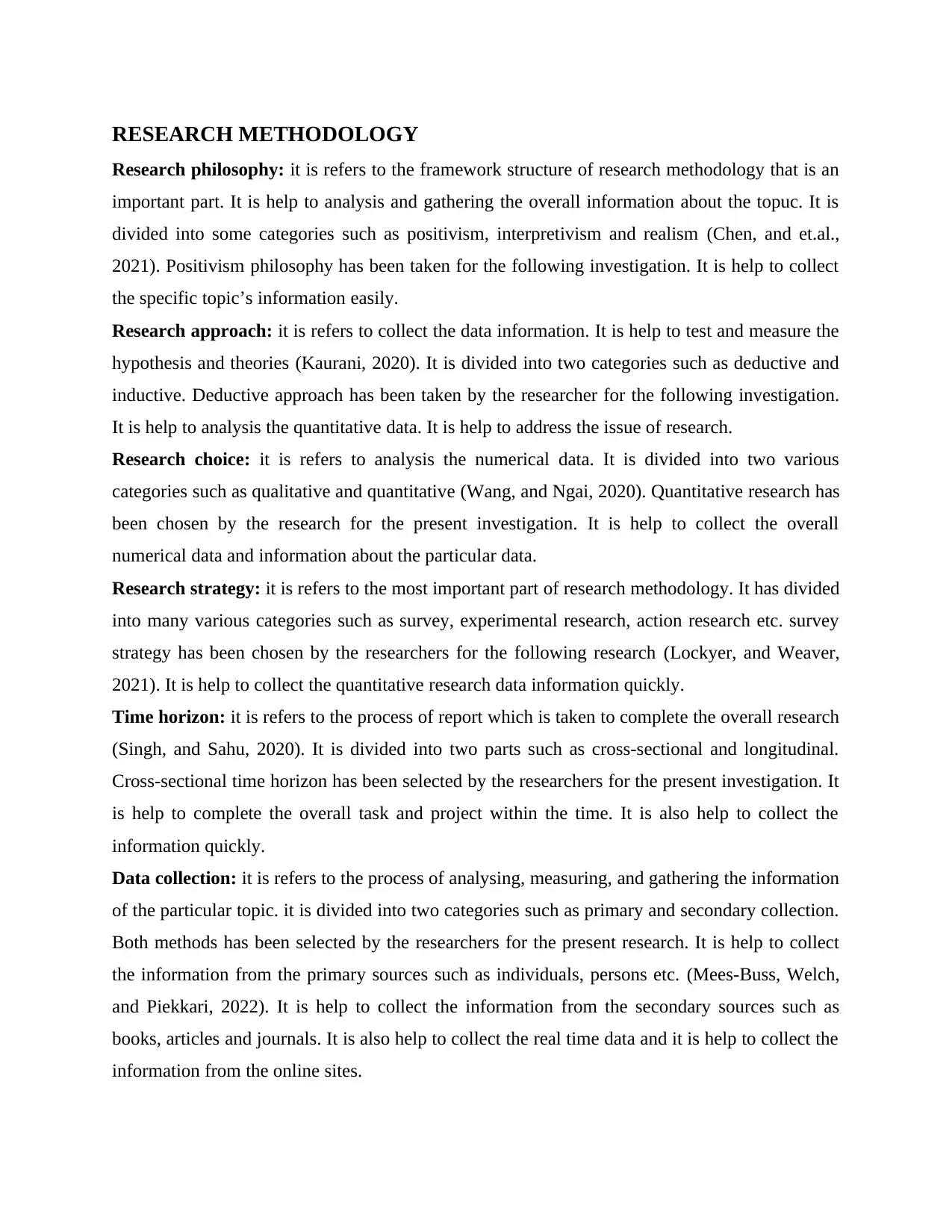
RESEARCH METHODOLOGY
Research philosophy: it is refers to the framework structure of research methodology that is an
important part. It is help to analysis and gathering the overall information about the topuc. It is
divided into some categories such as positivism, interpretivism and realism (Chen, and et.al.,
2021). Positivism philosophy has been taken for the following investigation. It is help to collect
the specific topic’s information easily.
Research approach: it is refers to collect the data information. It is help to test and measure the
hypothesis and theories (Kaurani, 2020). It is divided into two categories such as deductive and
inductive. Deductive approach has been taken by the researcher for the following investigation.
It is help to analysis the quantitative data. It is help to address the issue of research.
Research choice: it is refers to analysis the numerical data. It is divided into two various
categories such as qualitative and quantitative (Wang, and Ngai, 2020). Quantitative research has
been chosen by the research for the present investigation. It is help to collect the overall
numerical data and information about the particular data.
Research strategy: it is refers to the most important part of research methodology. It has divided
into many various categories such as survey, experimental research, action research etc. survey
strategy has been chosen by the researchers for the following research (Lockyer, and Weaver,
2021). It is help to collect the quantitative research data information quickly.
Time horizon: it is refers to the process of report which is taken to complete the overall research
(Singh, and Sahu, 2020). It is divided into two parts such as cross-sectional and longitudinal.
Cross-sectional time horizon has been selected by the researchers for the present investigation. It
is help to complete the overall task and project within the time. It is also help to collect the
information quickly.
Data collection: it is refers to the process of analysing, measuring, and gathering the information
of the particular topic. it is divided into two categories such as primary and secondary collection.
Both methods has been selected by the researchers for the present research. It is help to collect
the information from the primary sources such as individuals, persons etc. (Mees-Buss, Welch,
and Piekkari, 2022). It is help to collect the information from the secondary sources such as
books, articles and journals. It is also help to collect the real time data and it is help to collect the
information from the online sites.
Research philosophy: it is refers to the framework structure of research methodology that is an
important part. It is help to analysis and gathering the overall information about the topuc. It is
divided into some categories such as positivism, interpretivism and realism (Chen, and et.al.,
2021). Positivism philosophy has been taken for the following investigation. It is help to collect
the specific topic’s information easily.
Research approach: it is refers to collect the data information. It is help to test and measure the
hypothesis and theories (Kaurani, 2020). It is divided into two categories such as deductive and
inductive. Deductive approach has been taken by the researcher for the following investigation.
It is help to analysis the quantitative data. It is help to address the issue of research.
Research choice: it is refers to analysis the numerical data. It is divided into two various
categories such as qualitative and quantitative (Wang, and Ngai, 2020). Quantitative research has
been chosen by the research for the present investigation. It is help to collect the overall
numerical data and information about the particular data.
Research strategy: it is refers to the most important part of research methodology. It has divided
into many various categories such as survey, experimental research, action research etc. survey
strategy has been chosen by the researchers for the following research (Lockyer, and Weaver,
2021). It is help to collect the quantitative research data information quickly.
Time horizon: it is refers to the process of report which is taken to complete the overall research
(Singh, and Sahu, 2020). It is divided into two parts such as cross-sectional and longitudinal.
Cross-sectional time horizon has been selected by the researchers for the present investigation. It
is help to complete the overall task and project within the time. It is also help to collect the
information quickly.
Data collection: it is refers to the process of analysing, measuring, and gathering the information
of the particular topic. it is divided into two categories such as primary and secondary collection.
Both methods has been selected by the researchers for the present research. It is help to collect
the information from the primary sources such as individuals, persons etc. (Mees-Buss, Welch,
and Piekkari, 2022). It is help to collect the information from the secondary sources such as
books, articles and journals. It is also help to collect the real time data and it is help to collect the
information from the online sites.
⊘ This is a preview!⊘
Do you want full access?
Subscribe today to unlock all pages.

Trusted by 1+ million students worldwide
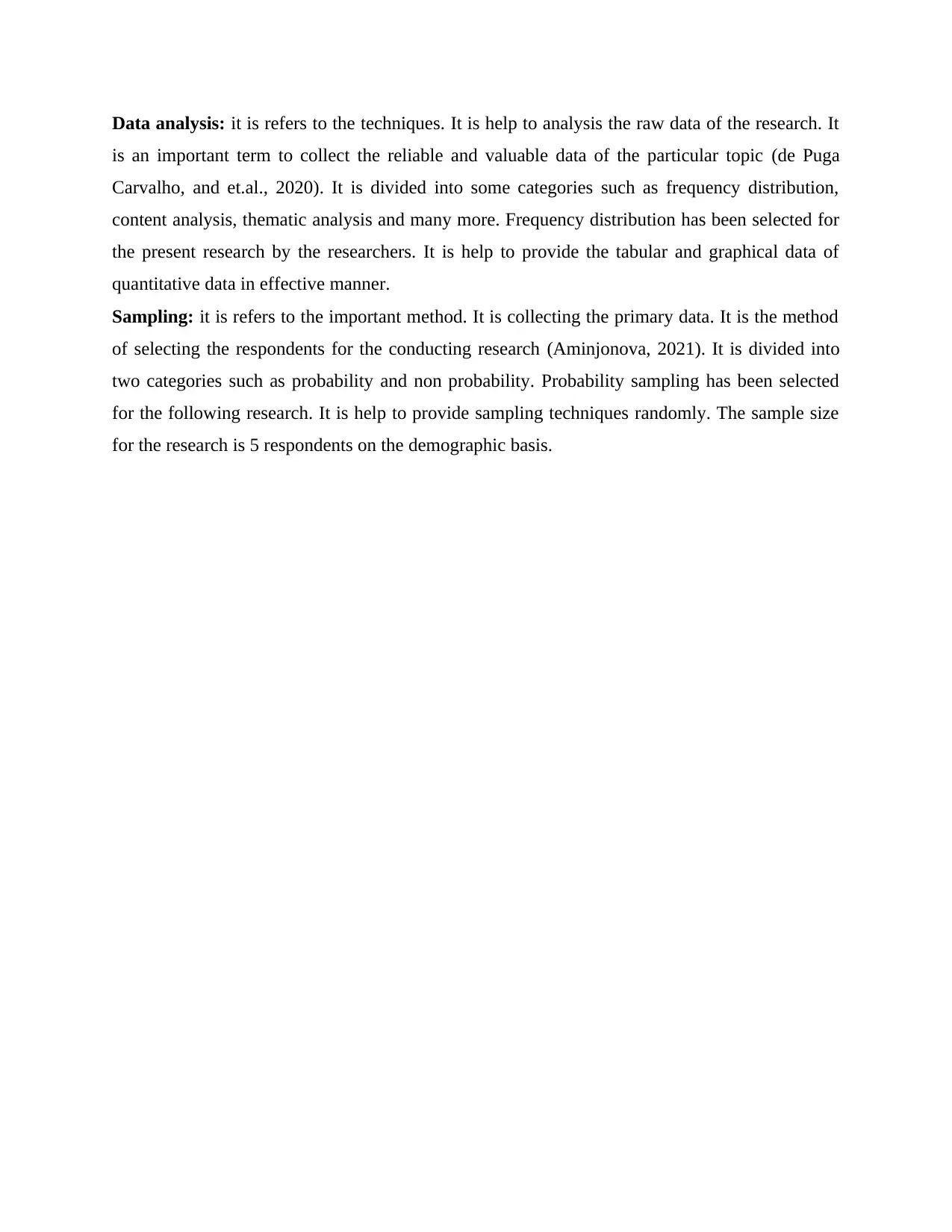
Data analysis: it is refers to the techniques. It is help to analysis the raw data of the research. It
is an important term to collect the reliable and valuable data of the particular topic (de Puga
Carvalho, and et.al., 2020). It is divided into some categories such as frequency distribution,
content analysis, thematic analysis and many more. Frequency distribution has been selected for
the present research by the researchers. It is help to provide the tabular and graphical data of
quantitative data in effective manner.
Sampling: it is refers to the important method. It is collecting the primary data. It is the method
of selecting the respondents for the conducting research (Aminjonova, 2021). It is divided into
two categories such as probability and non probability. Probability sampling has been selected
for the following research. It is help to provide sampling techniques randomly. The sample size
for the research is 5 respondents on the demographic basis.
is an important term to collect the reliable and valuable data of the particular topic (de Puga
Carvalho, and et.al., 2020). It is divided into some categories such as frequency distribution,
content analysis, thematic analysis and many more. Frequency distribution has been selected for
the present research by the researchers. It is help to provide the tabular and graphical data of
quantitative data in effective manner.
Sampling: it is refers to the important method. It is collecting the primary data. It is the method
of selecting the respondents for the conducting research (Aminjonova, 2021). It is divided into
two categories such as probability and non probability. Probability sampling has been selected
for the following research. It is help to provide sampling techniques randomly. The sample size
for the research is 5 respondents on the demographic basis.
Paraphrase This Document
Need a fresh take? Get an instant paraphrase of this document with our AI Paraphraser
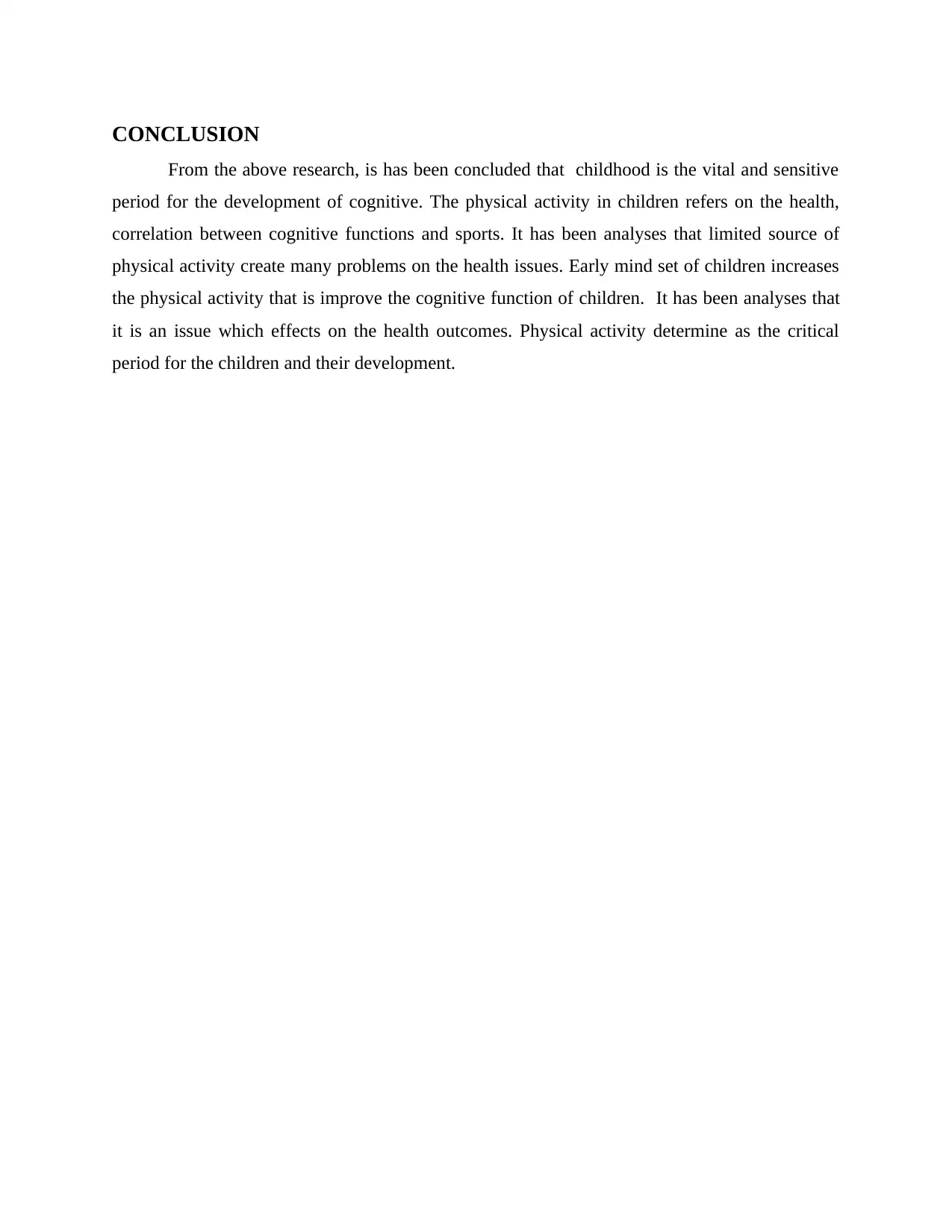
CONCLUSION
From the above research, is has been concluded that childhood is the vital and sensitive
period for the development of cognitive. The physical activity in children refers on the health,
correlation between cognitive functions and sports. It has been analyses that limited source of
physical activity create many problems on the health issues. Early mind set of children increases
the physical activity that is improve the cognitive function of children. It has been analyses that
it is an issue which effects on the health outcomes. Physical activity determine as the critical
period for the children and their development.
From the above research, is has been concluded that childhood is the vital and sensitive
period for the development of cognitive. The physical activity in children refers on the health,
correlation between cognitive functions and sports. It has been analyses that limited source of
physical activity create many problems on the health issues. Early mind set of children increases
the physical activity that is improve the cognitive function of children. It has been analyses that
it is an issue which effects on the health outcomes. Physical activity determine as the critical
period for the children and their development.
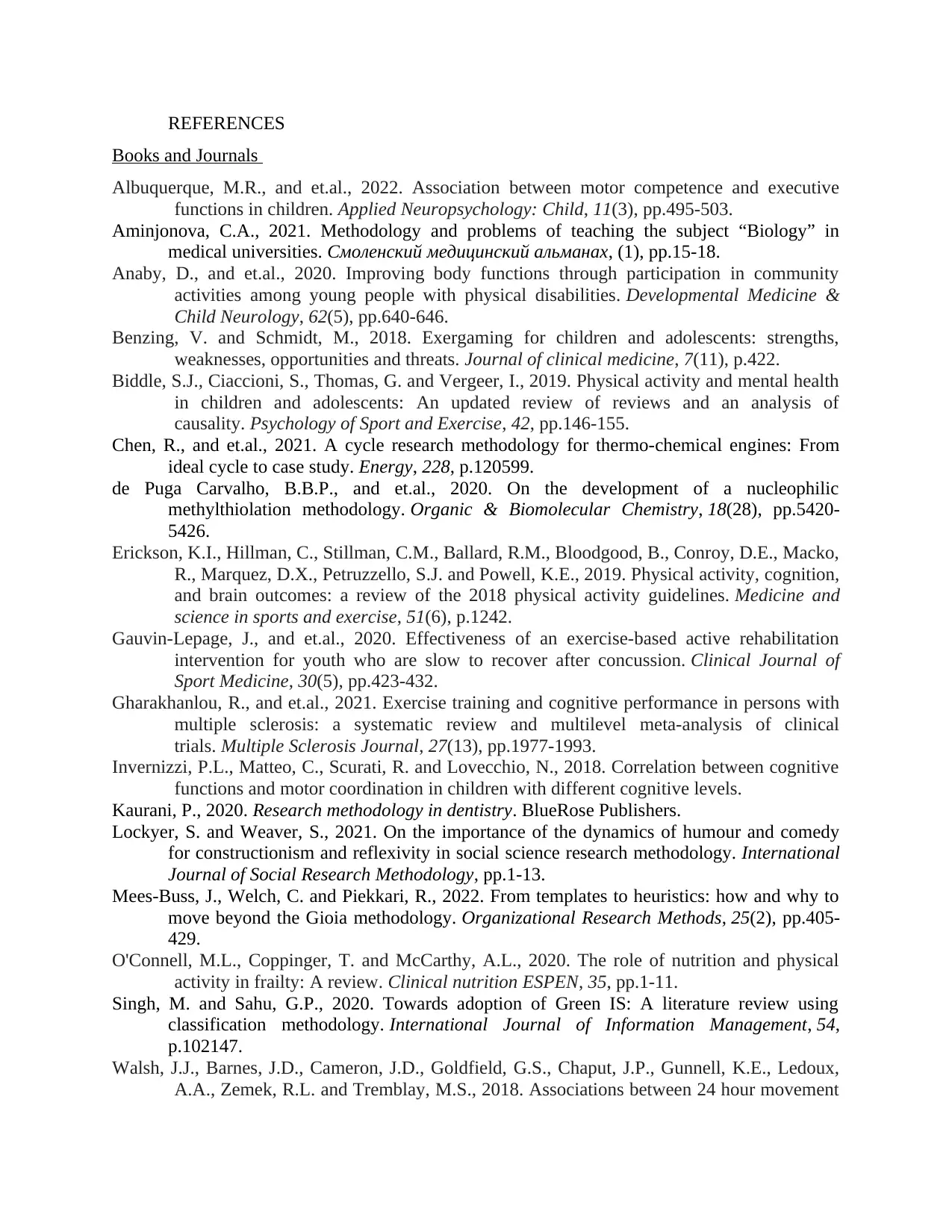
REFERENCES
Books and Journals
Albuquerque, M.R., and et.al., 2022. Association between motor competence and executive
functions in children. Applied Neuropsychology: Child, 11(3), pp.495-503.
Aminjonova, C.A., 2021. Methodology and problems of teaching the subject “Biology” in
medical universities. Смоленский медицинский альманах, (1), pp.15-18.
Anaby, D., and et.al., 2020. Improving body functions through participation in community
activities among young people with physical disabilities. Developmental Medicine &
Child Neurology, 62(5), pp.640-646.
Benzing, V. and Schmidt, M., 2018. Exergaming for children and adolescents: strengths,
weaknesses, opportunities and threats. Journal of clinical medicine, 7(11), p.422.
Biddle, S.J., Ciaccioni, S., Thomas, G. and Vergeer, I., 2019. Physical activity and mental health
in children and adolescents: An updated review of reviews and an analysis of
causality. Psychology of Sport and Exercise, 42, pp.146-155.
Chen, R., and et.al., 2021. A cycle research methodology for thermo-chemical engines: From
ideal cycle to case study. Energy, 228, p.120599.
de Puga Carvalho, B.B.P., and et.al., 2020. On the development of a nucleophilic
methylthiolation methodology. Organic & Biomolecular Chemistry, 18(28), pp.5420-
5426.
Erickson, K.I., Hillman, C., Stillman, C.M., Ballard, R.M., Bloodgood, B., Conroy, D.E., Macko,
R., Marquez, D.X., Petruzzello, S.J. and Powell, K.E., 2019. Physical activity, cognition,
and brain outcomes: a review of the 2018 physical activity guidelines. Medicine and
science in sports and exercise, 51(6), p.1242.
Gauvin-Lepage, J., and et.al., 2020. Effectiveness of an exercise-based active rehabilitation
intervention for youth who are slow to recover after concussion. Clinical Journal of
Sport Medicine, 30(5), pp.423-432.
Gharakhanlou, R., and et.al., 2021. Exercise training and cognitive performance in persons with
multiple sclerosis: a systematic review and multilevel meta-analysis of clinical
trials. Multiple Sclerosis Journal, 27(13), pp.1977-1993.
Invernizzi, P.L., Matteo, C., Scurati, R. and Lovecchio, N., 2018. Correlation between cognitive
functions and motor coordination in children with different cognitive levels.
Kaurani, P., 2020. Research methodology in dentistry. BlueRose Publishers.
Lockyer, S. and Weaver, S., 2021. On the importance of the dynamics of humour and comedy
for constructionism and reflexivity in social science research methodology. International
Journal of Social Research Methodology, pp.1-13.
Mees-Buss, J., Welch, C. and Piekkari, R., 2022. From templates to heuristics: how and why to
move beyond the Gioia methodology. Organizational Research Methods, 25(2), pp.405-
429.
O'Connell, M.L., Coppinger, T. and McCarthy, A.L., 2020. The role of nutrition and physical
activity in frailty: A review. Clinical nutrition ESPEN, 35, pp.1-11.
Singh, M. and Sahu, G.P., 2020. Towards adoption of Green IS: A literature review using
classification methodology. International Journal of Information Management, 54,
p.102147.
Walsh, J.J., Barnes, J.D., Cameron, J.D., Goldfield, G.S., Chaput, J.P., Gunnell, K.E., Ledoux,
A.A., Zemek, R.L. and Tremblay, M.S., 2018. Associations between 24 hour movement
Books and Journals
Albuquerque, M.R., and et.al., 2022. Association between motor competence and executive
functions in children. Applied Neuropsychology: Child, 11(3), pp.495-503.
Aminjonova, C.A., 2021. Methodology and problems of teaching the subject “Biology” in
medical universities. Смоленский медицинский альманах, (1), pp.15-18.
Anaby, D., and et.al., 2020. Improving body functions through participation in community
activities among young people with physical disabilities. Developmental Medicine &
Child Neurology, 62(5), pp.640-646.
Benzing, V. and Schmidt, M., 2018. Exergaming for children and adolescents: strengths,
weaknesses, opportunities and threats. Journal of clinical medicine, 7(11), p.422.
Biddle, S.J., Ciaccioni, S., Thomas, G. and Vergeer, I., 2019. Physical activity and mental health
in children and adolescents: An updated review of reviews and an analysis of
causality. Psychology of Sport and Exercise, 42, pp.146-155.
Chen, R., and et.al., 2021. A cycle research methodology for thermo-chemical engines: From
ideal cycle to case study. Energy, 228, p.120599.
de Puga Carvalho, B.B.P., and et.al., 2020. On the development of a nucleophilic
methylthiolation methodology. Organic & Biomolecular Chemistry, 18(28), pp.5420-
5426.
Erickson, K.I., Hillman, C., Stillman, C.M., Ballard, R.M., Bloodgood, B., Conroy, D.E., Macko,
R., Marquez, D.X., Petruzzello, S.J. and Powell, K.E., 2019. Physical activity, cognition,
and brain outcomes: a review of the 2018 physical activity guidelines. Medicine and
science in sports and exercise, 51(6), p.1242.
Gauvin-Lepage, J., and et.al., 2020. Effectiveness of an exercise-based active rehabilitation
intervention for youth who are slow to recover after concussion. Clinical Journal of
Sport Medicine, 30(5), pp.423-432.
Gharakhanlou, R., and et.al., 2021. Exercise training and cognitive performance in persons with
multiple sclerosis: a systematic review and multilevel meta-analysis of clinical
trials. Multiple Sclerosis Journal, 27(13), pp.1977-1993.
Invernizzi, P.L., Matteo, C., Scurati, R. and Lovecchio, N., 2018. Correlation between cognitive
functions and motor coordination in children with different cognitive levels.
Kaurani, P., 2020. Research methodology in dentistry. BlueRose Publishers.
Lockyer, S. and Weaver, S., 2021. On the importance of the dynamics of humour and comedy
for constructionism and reflexivity in social science research methodology. International
Journal of Social Research Methodology, pp.1-13.
Mees-Buss, J., Welch, C. and Piekkari, R., 2022. From templates to heuristics: how and why to
move beyond the Gioia methodology. Organizational Research Methods, 25(2), pp.405-
429.
O'Connell, M.L., Coppinger, T. and McCarthy, A.L., 2020. The role of nutrition and physical
activity in frailty: A review. Clinical nutrition ESPEN, 35, pp.1-11.
Singh, M. and Sahu, G.P., 2020. Towards adoption of Green IS: A literature review using
classification methodology. International Journal of Information Management, 54,
p.102147.
Walsh, J.J., Barnes, J.D., Cameron, J.D., Goldfield, G.S., Chaput, J.P., Gunnell, K.E., Ledoux,
A.A., Zemek, R.L. and Tremblay, M.S., 2018. Associations between 24 hour movement
⊘ This is a preview!⊘
Do you want full access?
Subscribe today to unlock all pages.

Trusted by 1+ million students worldwide
1 out of 15
Related Documents
Your All-in-One AI-Powered Toolkit for Academic Success.
+13062052269
info@desklib.com
Available 24*7 on WhatsApp / Email
![[object Object]](/_next/static/media/star-bottom.7253800d.svg)
Unlock your academic potential
Copyright © 2020–2025 A2Z Services. All Rights Reserved. Developed and managed by ZUCOL.





